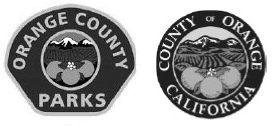Approximately every five years the Trademark Trial and Appeal Board (the “TTAB”) decides a Section 2(b) case. Here, Orange County sought to register a Circular Mark, serial number 87419378 (the “Circular Mark”), and a Badge Mark, serial number 87639750 (the “Badge Mark”). Both marks were refused registration under the Trademark Act Section 2(b), 15 U.S.C. § 1052(b).

The California Government Code, Section 25004, states that a county may adopt a seal but the adoption requires a two-step process. First, the seal must be adopted by the county Board of Supervisors. Second, the “description and impression of the seal shall be filed in the office of the county clerk.” Cal. Gov’t Code § 25004. Over one hundred years ago, Orange County adopted an official seal which is shown below.

Section 2(b) of the Trademark Act, 15 U.S.C. § 1052(b), prohibits registration on either the Principal or Supplemental Register of a mark that “[c]onsists of or comprises the flag or coat of arms or other insignia of the United States, or of any State or municipality, or of any foreign nation, or any simulation thereof.” This is because government insignia are not deemed “appropriate subjects of trademark law at all. Trademark law concerns itself with goods and services in commerce.” Renna v. Cnty. of Union, 88 F. Supp. 3d 310, 324 n.9 (D.N.J. 2014).
First, Orange County argued that the Circular Mark is not an insignia because it is not an official seal of the county. An insignia is defined as “a distinguishing mark or sign” and “an emblem.” An emblem is defined as “a device, symbol, or figure adopted and used as an identifying mark.” In re Cordua Rests. LP, 110 USPQ2d 1227, 1229 n.4 (TTAB 2014), aff’d, 823 F.3d 594, 118 USPQ2d 1632 (Fed. Cir. 2016).
While the proposed Circular Mark is not official, it appears on the county website, the Clerk-Recorder’s office website, signs for the Orange County government offices, Orange County maps, and the meeting room for the Orange County Board of Supervisors. Thus, the TTAB held that the Circular Mark would lead the general public to perceive the mark as an insignia of Orange County. Further, the TTAB held it does not matter that the Circular Mark is not an official insignia because Section 2(b) of the Trademark Act does not state that an insignia must be official. Therefore, the Circular Mark is an insignia according to Section 2(b) of the Trademark Act.
Second, Orange County argued it is not a municipality and the county can therefore register the Circular Mark as an insignia because Section 2(b) of the Trademark Act bars registration of an insignia “of any state or municipality of the United States ….” 15 U.S.C. § 1052(b); see Ceccato v. Manifattura Lane Gaetano Marzotto & Figli, S.p.A., 32 USPQ2d 1192, 1196. A municipality is defined as “[a] political unit, such as a city, town, or village, that is incorporated for local self-government.” November 27, 2018 Office Action at 7.
Here, the county’s website states the county is a local government entity and describes the Board of Supervisors functions as “oversee[ing] the management of the County government and its many special districts” as well as “adopt[ing] ordinances, resolutions and minute orders within the limits prescribed by State law.” May 7, 2020 Office Action at 21. Further, as stated in the California Constitution, the county has some powers of self-government. Thus, Orange County is a municipality for the purpose of determining if the Circular Mark may be registered under Section 2(b) of the Trademark Act.
Further, Orange County argued that the county was created and is governed by California law and thus the statute’s meaning of municipality should be determined by state law. However, it has been held, “[I]n the absence of a plain indication to the contrary, it is to be assumed when Congress enacts a statute that it does not intend to make its application dependent on state law.” Dickerson v. New Banner Inst., Inc., 460 U.S. 103, 119 (1983). Therefore, Orange County is a municipality and the statute’s meaning of municipality should be determined by Congress.
Third and finally, Orange County argued that based on the county’s prior registrations and other third party registrations, the Circular Mark should be allowed to be registered. This is because Orange County has already received a registration for a mark that includes the Circular Mark they wish to register. The registered mark (“Orange County Parks”) can be seen below next to the proposed Circular Mark.

However, it has been determined that the Circular Mark in its entirety is an insignia. The Circular Mark only appears as the center portion of the Orange County Parks mark and the TTAB held there was no determination to be made whether the center portion constitutes an insignia. Further, the [US]PTO’s allowance of such prior registrations does not bind the [Trademark Trial and Appeal] Board or this court.”); In re Finisar Corp., 78 USPQ2d 1618, 1621 (TTAB 2006). Therefore, the Circular Mark is not registerable based on prior and third party marks.
In conclusion, the Circular Mark is an insignia of a municipality as determined by Congress’s definition of municipality and the refusal to register the Circular Mark under Section 2(b) of the Trademark Act, 15 U.S.C. § 1052(b) is affirmed.
Section 2(b) of the Trademark Act prohibits registration of a mark that includes an insignia of a municipality. In re Fam. Emergency Room, LLC, 121 USPQ2d, 1886, 1889 n.2 (TTAB 2017). Since the Circular Mark is an insignia of a municipality, the TTAB found the Badge Mark is also an insignia because it encompasses the Circular Mark in its entirety.
Thus, registration of the Badge Mark is barred under Section 2(b) of the Trademark Act, 15 U.S.C. § 1052(b).
The TTAB affirmed that the Circular Mark and the Badge Mark are barred from registry under Section 2(b).
777 South Flagler Drive
Phillips Point East Tower, Suite 1000
West Palm Beach, FL 33401